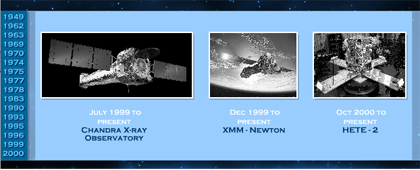From One X-ray Mission to Another
As many of this blog's readers may know, Chandra is NASA's flagship X-ray mission but it's not the only major X-ray telescope in orbit. The other one is XMM-Newton, which was launched by the European Space Agency (ESA) just five months after Chandra in 1999. The great thing about Chandra and XMM-Newton is that many of their capabilities are complementary. In other words, scientists often use both and can combine the data for even stronger results.

Major Milestones In X-ray Astronomy (flash)
So there was quite a bit of nervousness in the Chandra community when word spread the XMM-Newton ran into some trouble last week. The good news is that the scare is over and XMM-Newton seems to be on the path to restored health. Below is an email sent to the scientific community that describes what happened and what the plans are going forward. From one X-ray mission to another, we are wishing for a full and speedy recovery.
(FYI, here’s a quick reference for a couple of the acronyms below. ESOC=European Space Operations Center; ESTEC=European Space Research and Technology Center.)
-----------------------------------------------------------------------------
On Saturday 18 October ESA lost contact with the XMM-Newton X-ray observatory (see http://www.esa.int/esaSC/SEM268RTKMF_index_0.html). XMM-Newton uses different ground stations depending on which gives the strongest signal with one of the spacecraft's two antennas which point in different directions. On Saturday evening XMM-Newton was approaching perigee passage with the instruments in safe configurations and communicating normally with the Santiago ground station in Chile. After the spacecraft moved out of visibility from Santiago it was expected to be picked-up by ESA's Villafranca ground station in Spain about an hour later. The usual time-tagged command had been loaded on-board to change the operating antenna to the one pointing towards Villafranca. However, the telemetry signal from the spacecraft was not detected at the expected time and standard recovery procedures did not re-establish contact.
These activities were repeated the next day, but the problem was still present even when other ESA ground stations were used. This confirmed that the loss of contact was related to either an on-board problem or a catastrophic event in orbit. On Monday 20 October images of the track of XMM-Newton against the night sky taken by amateur astronomers in Germany's Starkenburg observatory showed that the satellite was still in one piece. Other ground-based telescopes at Zimmerwald in Switzerland of the astronomy institute of the University of Bern and the ESA Space Debris telescope at Tenerife (Canary Islands, Spain), the German FGAN radar near Bonn and NASA and US Space Surveillance network also observed the satellite and it was possible to confirm that it was in its expected orbit.
The next step on Tuesday 21 October was to use the more powerful ESA 35-meter ground station at New Norcia (Western Australia) that was pointed in the direction of XMM-Newton using a special radio-science mode. A weak signal was detected from the spacecraft helping confirm suspicions that the antenna switch was stuck in an intermediate position. Engineers at ESOC, supported by European Industry and experts from other ESA sites, attempted to command the spacecraft, but the commanding threshold was still not reached by around 8 dB.
Consequently ESOC declared a spacecraft emergency and requested support from NASA's Deep Space Network Goldstone antenna. Due to its location Goldstone provides visibility of the spacecraft when it is very close to the Earth so allowing a higher signal power at the spacecraft. ESOC sent commands that moved the antenna switch back to its last working position and then managed to obtain radio contact with the spacecraft with ESA's 15-metre ground station in Villafranca on Wednesday 22 October around 18:10 Central European Summer Time (CEST).
Since then XMM-Newton is safe and fully under control by the mission control team at ESOC. There were no unexpected events during the 4-days without normal communications. Currently there are no plans to move the antenna switch and investigations involving ESOC, ESTEC, and industry experts are continuing. Until the failure mode is better understood, we do not plan to use the available backup switch and instead are concentrating on operational modes that do not require the use of these switches:
* XMM-Newton will re-start observations on Monday November 3 using only one antenna as a temporary measure. Due to the favourable celestial geometry this will allow coverage of nearly all the orbit, expect for around 6 hours near perigee. The coverage available on antenna will slowly decrease over the next months, such that in around 6 months nearly all the orbit will only be visible with the second antenna.
* In parallel two operational concepts are being investigated which should allow nominal operations to resume by the end of November. The first concept envisages using both transponders simultaneously with each providing a signal to its own antenna. The second concept assumes that the transponders will be switched-on and -off to only power the antenna pointing towards the required ground station. Both concepts avoid having to use the antenna switch again and have advantages and disadvantages which will be evaluated in the next weeks before the deciding on the way forward.
A.N. Parmar
XMM-Newton Mission Manager
Category:
- Log in to post comments
